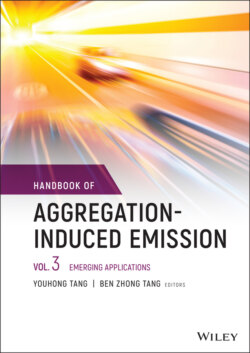Читать книгу Handbook of Aggregation-Induced Emission, Volume 3 - Группа авторов - Страница 55
4.2.4 Hybrid and Functional Materials
ОглавлениеAI‐ECL of functional hydrogels formed by gold nanoclusters (Au‐NC) linked with bivalent cations such as Ca2+ was reported for the first time by Wang and coworkers (Figure 4.9) [92]. TEM studies revealed that the formed hydrogel has a hydroxyl apatite like structure because of coexistence of calcium, hydroxyl groups from ribose and phosphates group. The nanoclusters showed to be sensitive to bivalent cations, when they are coated with adenosine phosphates (mono‐, di‐, and tri‐), demonstrating that the interaction between these cations and phosphate groups increases the PL for AIE effect. This interaction reduces the nonradiative relaxation of excited states by restricting the intramolecular vibration and rotation of capping ligands and induces a significant emission enhancement. Together with PL, their ECL emission enhancement was observed and examined. The ECL increased significantly during anodic scan in 2‐[4‐(2‐hydroxyethyl)‐1‐piperazinyl]ethanesulfonic acid (HEPES, pH 7.0) upon addition of TEA as coreactant. The peak intensity revealed a 50‐fold enhancement comparing to the AuATP NCs alone without Ca2+ (Figure 4.9d). The enhancement was found much higher than the PL, attributing to this improved signal, a better adsorption of the hydrogel to the electrode surface than ultrasmall NCs, as TEM showed (Figures 4.9b–c). Thanks to the great enhancement by ECL, this hydrogel was used to build a sensor platform for Calmodulin, which is a binding protein of Ca2+ and it may sense it selectively by affecting the AI‐ECL emission. On the basis of the binding power, the ECL decreased with increasing concentration of Calmodulin in the range 0.3–50 μg/ml. Then, this biomacromolecule‐responsive AI‐ECL type hydrogel may be potentially use for the design of bivalent metal ions relevant to biological events like in neurosignal transportation in synapse, chloroplast, and zin‐finger motif.
Figure 4.9 (a) Illustration of bivalent cations induced aggregation of NCs with CaM regulated ECL; (b–c) TEM images of AuATP NCs before and after addition of Ca2+; (d) Potential‐dependent ECL emission by AuATP NCs of 0.1 mg/ml and different concentration of Ca2+ (from left to right: 0, 100, 200, 300, 400, and 500 × 10−6 M) using cyclic voltammetry scans. Inset: the corresponding cyclic voltammetry curves.
Source: Readapted from Ref. [92].
Recently, a novel 2D ultrathin hybrid metal‐organic layer (MOL) was built starting from H4ETTC (H4ETTC = 4′,4″′,4″′′,4″″′′′‐(ethene‐1,1,2,2‐tetrayl)tetrakis(([1,1′‐biphenyl]‐4‐carboxylic acid))), which is known to be an AIE‐luminophore [93]. The newly synthesized HfETTC‐MOL exhibited higher ECL intensity and efficiency than the monomers H4ETTC, H4ETTC aggregates, and 3D bulk HfETTC‐MOF, not only because ETTC ligands were immobilized in a rigid MOL matrix with consequent restriction of intramolecular free rotation and vibration, but also because porous ultrathin 2D MOL greatly shortened the transportation distance of ions, electrons, and coreactant TEA. The system was then used for the detection of carcinoembryonic antigen, overexpressed in most human malignancies.
